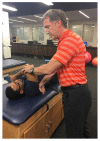Superior Labral Anterior to Posterior Tear Management in Athletes
- PMID: 30197712
- PMCID: PMC6110067
- DOI: 10.2174/1874325001812010303
Superior Labral Anterior to Posterior Tear Management in Athletes
Abstract
Background: The diagnosis and treatment of Superior Labrum Anterior to Posterior (SLAP) tears have been evolving and controversial. The lack of clear diagnostic criteria on physical examination, Magnetic Resonance Imaging (MRI), and arthroscopic evaluation clouds the issue. The high rate of MRI diagnosed SLAP lesions in the asymptomatic population of athletes and non-athletes warrants consideration when planning treatment for those with shoulder pain.
Objective: To provide information on the evaluation, diagnosis and management of SLAP tears in athletes.
Methods: The results of a structured non-operative rehabilitation program are discussed and compared to traditional surgical techniques. The evolution of the author's treatment algorithm is presented. Results: The successful return to overhand throwing is more common with non-operative treatment than with surgical.
Conclusion: A rehabilitation program focused on stretching the posterior capsule and correcting scapular posture is more successful than surgery for most throwers with SLAP lesions.
Keywords: Baseball Players; MRI; Overhead Athletes; SLAP; SLAP Repair; Superior Labrum Anterior Posterior tear.
Figures



References
-
- Kumar V.P., Satku K., Balasubramaniam P. The role of the long head of biceps brachii in the stabilization of the head of the humerus. Clin. Orthop. Relat. Res. 1989;(244):172–175. - PubMed
-
- Hitchcock HH, Bechtol CO. Painful shoulder; observations on the role of the tendon of the long head of the biceps brachii in its causation. Journal of Bone and Joint Surgery – American. 1948;30A(2):263–273. - PubMed
Publication types
LinkOut - more resources
Full Text Sources
Other Literature Sources
